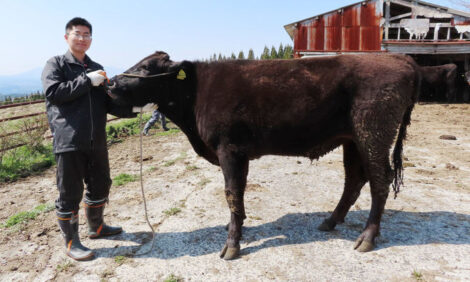



The End Of The Road For Rinderpest
Sometime in the next 18 months, one of the most devastating animal diseases, rinderpest, will be officially declared eradicated.It will be the first time in history that humankind has succeeded in killing off an animal disease and only the second time a disease has been consigned to the dustbin as a result of human efforts. (The first was smallpox, in 1980.)
The victory comes after an intense decades-long campaign, spearheaded by the Food and Agriculture Organisation (FAO) and involving a broad alliance of partners, which targeted the remaining pockets of rinderpest, aiming to wipe it out, once and for all.
Rinderpest does not affect humans directly but it is lethal to the cattle and hoofed animals upon which they depend for food, income, and draught power. Death rates during outbreaks can approach 100 per cent.
Caused by a virus and spread by contact and contaminated materials, rinderpest has destroyed countless millions of cattle, buffalo, yaks and their wild relatives, causing staggering economic losses and contributing to famine and social unrest for thousands of years.
Carried into Europe from Asia by invading tribes, outbreaks of rinderpest hit the Roman Empire in AD 376-386 and are suspected as having played a role in its decline and collapse.
* "Animals affected with rinderpest have a high fever, erosions in the mouth, diarrhoea and rapidly become dehydrated and emaciated." |
|
|
Recurring epidemics in France during the 1700s provoked famine and drops in agricultural productivity, feeding into the unrest that culminated in the revolution of 1789.
When rinderpest was introduced into sub-Saharan Africa at the end of the 19th century it killed off 80 to 90 per cent of all cattle in the region, leaving the livelihoods of farmers and pastoralists in tatters, causing widespread famine and rendering the region weak in the face of European colonisation.
At its height in the 1920s, the rinderpest footprint extended from Scandinavia to the Cape of Good Hope and from the Atlantic shore of Africa to the Philippine archipelago, with one outbreak reported in Brazil and another in Australia.
In the early 1980s, the disease was still ravaging livestock herds around the world, with devastating epidemics hitting South Asia, the Middle East and Africa. Losses in Nigeria in the 1980s totalled $2 billion. A 1994 outbreak in northern Pakistan wiped out more than 50,000 cattle and buffalo before being brought under control with help from FAO.
How FAO helped turn things around
Although some countries made progress during the 20th century in dealing with rinderpest on their own territory, it continued to survive and thrive in others, forming reservoirs from which it regularly broke out.
Using a newly developed vaccine, after 1960 efforts were made to combat rinderpest on a broader scale through various regional campaigns. While successful at first, these programmes usually were discontinued too soon and allowed the disease to make dramatic comebacks.
Like highly pathogenic avian influenza of the H5N1 variety or the pandemic H1N1/2009 flu virus today, rinderpest seemed unstoppable.
Starting in the late 1980s, the FAO began to convene a series of regular meetings involving animal health authorities from around the globe as well key international organisations like OIE and the African Union's Inter-African Bureau for Animal Resources.
The science needed to deal with rinderpest was there. Past successes at the regional level showed that it could be combated effectively. What would it take to do away with the disease, once and for all, FAO asked?
The answer that came out of the talks: a high-level umbrella programme that would weave together national and regional activities into a concerted world-wide campaign against the disease. FAO, participants agreed, was the institution best-suited to oversee such a network.
And so in 1994 the Global Rinderpest Eradication Programme (GREP) was launched, after a series of consultations to gather recommendations from experts around the world. The GREP was set up to act as a spider at the centre of a web—a global coordination mechanism that would allow the international community to jointly undertake rinderpest control in a systematic and comprehensive way.
With FAO acting as the coordinating Secretariat and involving a large group of partner governments, agencies and organisations, the GREP initially focused on charting out the true geographical distribution of rinderpest, getting a better understanding of rinderpest's epidemiology, and helping countries cope with emergency situations.
Phase two involved targeted action at the local level where the virus was in circulation.
FAO channelled vast amounts of technical assistance to countries to help them first extinguish outbreaks and then put in place the systems and measures needed to stay free of it.
Teaching farmers how to recognise and report the disease, establishing emergency response plans, biosecurity protocols, and national programmess for monitoring and control and training veterinarians on designing and implementing blood survey campaigns followed by clinical surveillance and setting up laboratories were all important in controlling the disease.
The Joint FAO/IAEA Division in Vienna worked to develop and then transfer new rinderpest diagnostic technology to developing countries. GREP, the World Organisation for Animal Health (OIE) and FAO/IAEA developed performance indicators to assess the campaign's progress. In the face of this cohesive effort, slowly but surely rinderpest began to retreat.
Now GREP's focus became assisting countries in undertaking the painstaking work of establishing that the rinderpest pathogen was fully eradicated in their animal populations in order to earn a disease-free status from OIE, the international certification body for animal diseases.
Between 1994 and 2009, around 170 countries and territories succeeded in eliminating rinderpest and acquired OIE certification thanks to GREP support. By early 2000, the rinderpest virus was contained to parts of the Somali Ecosystem (SES), an area covering southern Somalia and adjoining parts of Ethiopia and Kenya, where its footprint could still be found in the bloodstreams of certain animal populations. The last-ever outbreak of the disease occurred in Kenya, in 2001.
Today the last reservoir appears to have been cleared; setting the stage for a full global certification of rinderpest eradication. FAO is committed to seeing the last control activities completed next year in partnership with OIE and all concerned stakeholders.
Major gains in food production and income
FAO estimates that additional production due to rinderpest's eradication in India alone from 1965 to 1998 added up to $289 billion. The benefits in Africa have been estimated at around $1 billion per year during the same period. Billions of dollars have no doubt also been generated in other countries, such as Sri Lanka, Pakistan, Afghanistan, Iran, Iraq and Turkey.
"Most importantly, the protection of cattle in sub-Saharan Africa, the Near East and Asia has improved both food and income streams for hundreds of thousands, if not millions, of pastoral people and small farmers and helped avoid famine and the loss of draught power in agricultural communities," says Felix Njeumi of the GREP Secretariat at FAO.
There has been a gain for the conservation of biodiversity, as well, as species that may be endangered will now have one less problem to face.
"When you think about it, it's quite remarkable that we are where we are today," says Juan Lubroth, FAO's Chief Veterinary Officer. "This is a disease that has been an absolute scourge in agriculture for millennia."
"But if you look at it another way, the solution was simple. We had the know-how. We had the vaccine. What was missing was, in the first place, adequate and targeted investment, and, secondly, a cohesive global coordinating mechanism. Once we had those, solving the problem was just a matter of time. The very substantial investments of many development partners in this programme, first among them the European Commission, and the strong commitment of national governments and of mandated regional organisations have been instrumental in this success story," he adds.



